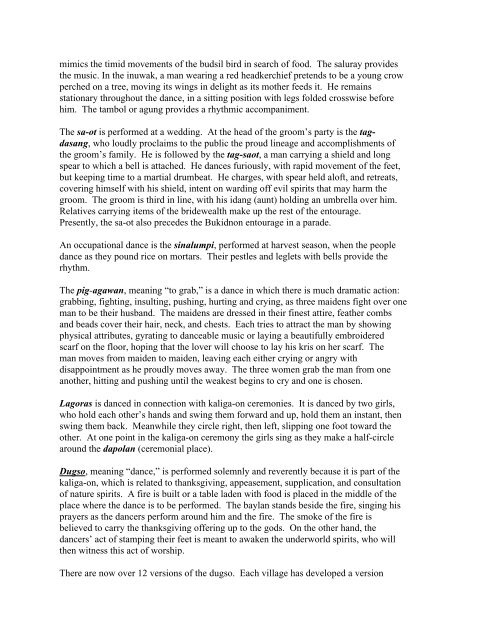You also want an ePaper? Increase the reach of your titles
YUMPU automatically turns print PDFs into web optimized ePapers that Google loves.
mimics the timid movements of the budsil bird in search of food. The saluray provides<br />
the music. In the inuwak, a man wearing a red headkerchief pretends to be a young crow<br />
perched on a tree, moving its wings in delight as its mother feeds it. He remains<br />
stationary throughout the dance, in a sitting position with legs folded crosswise before<br />
him. The tambol or agung provides a rhythmic accompaniment.<br />
The sa-ot is performed at a wedding. At the head of the groom’s party is the tagdasang,<br />
who loudly proclaims to the public the proud lineage and accomplishments of<br />
the groom’s family. He is followed by the tag-saot, a man carrying a shield and long<br />
spear to which a bell is attached. He dances furiously, with rapid movement of the feet,<br />
but keeping time to a martial drumbeat. He charges, with spear held aloft, and retreats,<br />
covering himself with his shield, intent on warding off evil spirits that may harm the<br />
groom. The groom is third in line, with his idang (aunt) holding an umbrella over him.<br />
Relatives carrying items of the bridewealth make up the rest of the entourage.<br />
Presently, the sa-ot also precedes the <strong>Bukidnon</strong> entourage in a parade.<br />
An occupational dance is the sinalumpi, performed at harvest season, when the people<br />
dance as they pound rice on mortars. Their pestles and leglets with bells provide the<br />
rhythm.<br />
The pig-agawan, meaning “to grab,” is a dance in which there is much dramatic action:<br />
grabbing, fighting, insulting, pushing, hurting and crying, as three maidens fight over one<br />
man to be their husband. The maidens are dressed in their finest attire, feather combs<br />
and beads cover their hair, neck, and chests. Each tries to attract the man by showing<br />
physical attributes, gyrating to danceable music or laying a beautifully embroidered<br />
scarf on the floor, hoping that the lover will choose to lay his kris on her scarf. The<br />
man moves from maiden to maiden, leaving each either crying or angry with<br />
disappointment as he proudly moves away. The three women grab the man from one<br />
another, hitting and pushing until the weakest begins to cry and one is chosen.<br />
Lagoras is danced in connection with kaliga-on ceremonies. It is danced by two girls,<br />
who hold each other’s hands and swing them forward and up, hold them an instant, then<br />
swing them back. Meanwhile they circle right, then left, slipping one foot toward the<br />
other. At one point in the kaliga-on ceremony the girls sing as they make a half-circle<br />
around the dapolan (ceremonial place).<br />
Dugso, meaning “dance,” is performed solemnly and reverently because it is part of the<br />
kaliga-on, which is related to thanksgiving, appeasement, supplication, and consultation<br />
of nature spirits. A fire is built or a table laden with food is placed in the middle of the<br />
place where the dance is to be performed. The baylan stands beside the fire, singing his<br />
prayers as the dancers perform around him and the fire. The smoke of the fire is<br />
believed to carry the thanksgiving offering up to the gods. On the other hand, the<br />
dancers’ act of stamping their feet is meant to awaken the underworld spirits, who will<br />
then witness this act of worship.<br />
There are now over 12 versions of the dugso. Each village has developed a version
















